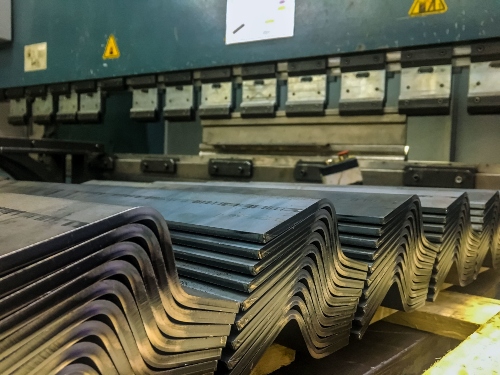 Blog originally published on May 15, 2020. Updated on November 18, 2022.
Blog originally published on May 15, 2020. Updated on November 18, 2022.
Sheet metal is everywhere, even if you don't think about it too much. Sheet metal parts make up many electronics, such as the durable and light casings of the phones and laptops you use every day. It is also found in heating and cooling systems, and other parts in just about every field. The way to get these materials is through a process called sheet metal fabrication. But how does the sheet metal fabrication process work? Let's take a closer look!
Through sheet metal fabrication, raw materials such as hot-rolled steel, cold-rolled steel, aluminum, and corrosion-resistant brass transform into useful equipment that techs in many fields need for their daily work. There are many techniques to get exactly what a client needs from a component, but there are some common steps that just about all sheet metal fabrication services follow. Keep reading to learn more about each step in the sheet metal fabrication process.
1. Design
For all sheet metal fabrication projects, planning comes first. We design a final product before ever touching the flat sheets of metal. The client will provide the sheet metal design or at least an estimate of what they want. Other times, we will create a blueprint first. Then that blueprint gets used to create a rough draft for the final design. We also consider material thickness. Once everyone agrees on the plan, the next step begins.
2. Blank-Cutting of Sheet Metal Materials
Sheet metal comes in big coils of materials. We take these coils and cut them into the lengths and sheet thickness our client needs. We cut a flat sheet of metal out of a larger sheet through a process called blank-cutting. We cut the blank to match the final product. Cutting sheet metal is accomplished with shearing machines or through plasma cutting, laser cutting, or water jet cutting.
3. Punching
Now that the sheet metal is in its final size, it is time to punch some holes. The process of punching makes holes in shapes or patterns in the stainless steel sheets. The client and our team create the holes based on the type and specifications for the hole diameters in the design plan.
4. Bending
Next, it's time to form sheet metal into the appropriate shape. Under the right conditions, sheet metal can safely bend. We make the bends in a specific order so as not to interfere with the next bend in the sequence. The standard tool for sheet metal bending is known as the press brake.
5. Assembly
Once we have all the parts, we assemble them into a final form. This step is when we weld, rivet, and bond parts into place. We can use CO2 or spot welding to join or alter parts.
6. Finishing
Now for the finishing touches. Sheet metal finishes may include cleaning, powder coating, painting, galvanizing, or other last steps. In other cases, additional heat treatment is necessary to bring the project to completion.
7. Quality Control
Now the product is in our hands! But our job isn't done yet. Before sending sheet metal projects off, we thoroughly check them, comparing the final product to the design requirements. If anything does not meet the design, we send it back for correcting. Then we recheck before clearing the product for final delivery.
JML Sheet Metal - Professional Sheet Metal Fabricators
There you have it, the basic steps of sheet metal fabrication. These are the steps we take every day to give our clients exactly what they need.
JML Sheet Metal creates fabricated sheet metal products for commercial and residential clients. We are here as a resource, a supplier, and an installer for a wide variety of sheet metal applications.
For professional sheet metal fabrication services, contact us today. We'd love to hear about your next project!


